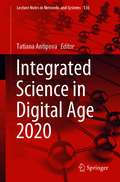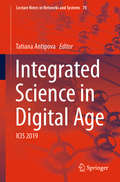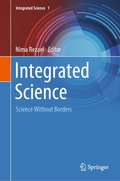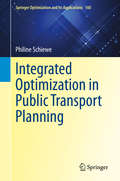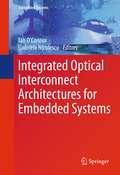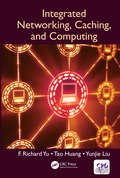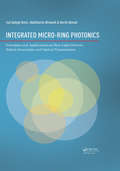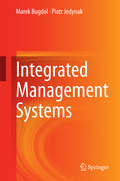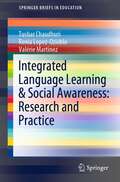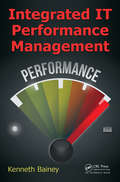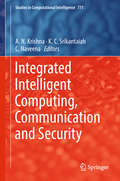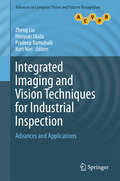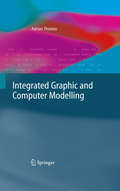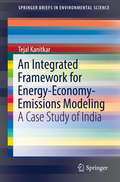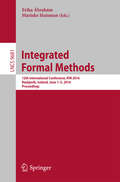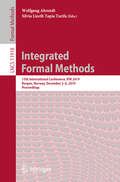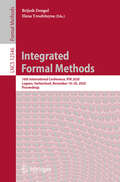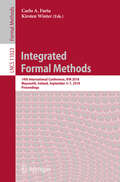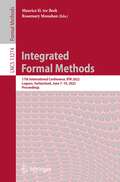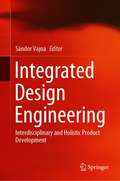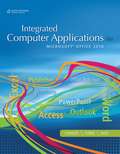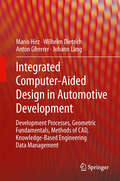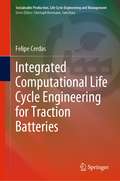- Table View
- List View
Integrated Science in Digital Age 2020 (Lecture Notes in Networks and Systems #136)
by Tatiana AntipovaThis book presents the proceedings of the 2020 International Conference on Integrated Science in Digital Age, which was jointly supported by the Institute of Certified Specialists (Russia) and Springer, and was held on May 1–3, 2020.The conference provided an international forum for researchers and practitioners to present and discuss the latest innovations, trends, results, experiences and concerns in the various areas of integrated science in the digital age. The main goal of the conference was to efficiently disseminate original findings in the natural and social sciences, covering topics such as blockchain & cryptocurrency; computer law & security; digital accounting & auditing; digital business & finance; digital economics; digital education; digital engineering; machine learning; smart cities in the digital age; health policy & management; and information management.
Integrated Science in Digital Age: ICIS 2019 (Lecture Notes in Networks and Systems #78)
by Tatiana AntipovaThis book gathers selected papers presented at the 2019 International Conference on Integrated Science in Digital Age (ICIS 2019), which was jointly supported by the Institute of Certified Specialists (ICS), Russia and Springer and held in Batumi, Georgia on May 10–12, 2019. The ICIS 2019 received roughly 50 contributions, by authors hailing from six countries. Following a peer-review process, the Scientific Committee – a multidisciplinary group of 110 experts from 38 countries around the globe – selected roughly 60% for publication. The main topics covered include: Artificial Intelligence Research; Digital Business & Finance; Educational Sciences; Health Management Informatics; Public Administration in the Digital Age; and Social Problem-solving.
Integrated Science: Science Without Borders (Integrated Science #1)
by Nima RezaeiThe “INTEGRATED SCIENCE: Science without Borders” is the first volume of INTEGRATED SCIENCE Book series, aims to publish the results of the most update ideas and reviews in transdisciplinarity fields, to highlight integration of different disciplines, including formal sciences, physical-chemical sciences and engineering, biological sciences, medical sciences, and social sciences. This is especially focused on the research involving the integration of two of more academic fields offering an innovative view, which is one of the main focuses of Universal Scientific Education and Research Network (USERN); science without borders. The whole world is suffering from complex problems; these are actually borderless problems; so, borderless solution could be the solution for such complex problems. Transdisciplinarity, as a domain that researchers work jointly, using shared conceptual framework drawing together disciplinary-specific theories, concepts and approaches to address common problem. Lack of confidence, lack of expertise, complexities of healthcare, the confusing nature of healthcare environments and lack of organization and standardization became obstacles to successful communication. Consequently, the book is to provide an overview of the basic elements of transdisciplinary studies and integrated science. The unique aspect of this book, privileging it from other books, is covering all aspects of science as a true one nature.
Integrated Optimization in Public Transport Planning (Springer Optimization and Its Applications #160)
by Philine SchieweThis book is one of the first to include an extensive discussion of integrated public transport planning. In times of growing urban populations and increasing environmental awareness, the importance of optimizing public transport systems is ever-developing. Three different aspects are presented: line planning, timetabling, and vehicle scheduling. Classically, challenges concerning these three aspects of planning are solved sequentially. Due to their high interdependence, the author presents a clear and detailed analysis of innovative, integrated models with accompanied numerical experiments performed to assess, and often support, the benefits of integration. The book will appeal to a wide readership ranging from graduate students to researchers.
Integrated Optical Interconnect Architectures for Embedded Systems
by Ian O'Connor Gabriela NicolescuThis book provides a broad overview of current research in optical interconnect technologies and architectures. Introductory chapters on high-performance computing and the associated issues in conventional interconnect architectures, and on the fundamental building blocks for integrated optical interconnect, provide the foundations for the bulk of the book which brings together leading experts in the field of optical interconnect architectures for data communication. Particular emphasis is given to the ways in which the photonic components are assembled into architectures to address the needs of data-intensive on-chip communication, and to the performance evaluation of such architectures for specific applications.
Integrated Networking, Caching, and Computing
by F. Richard Yu Tao Huang Yunjie LiuThis book features the major research advances on integrated networking, caching, and computing. Information-centric networking-based caching is one of the promising techniques for future networks. The cloud computing paradigm has been widely adopted to enable convenient, on-demand network access to a shared pool of configurable computing resources. In addition, fog/edge computing is proposed to deploy computing resources closer to end devices. From the perspective of applications, network, cache and compute are underlying enabling resources. How to manage, control and optimize these resources can have significant impacts on application performance.
Integrated Micro-Ring Photonics: Principles and Applications as Slow Light Devices, Soliton Generation and Optical Transmission
by Iraj Sadegh Amiri Abdolkarim Afroozeh Harith AhmadMicro-ring resonators (MRRs) are employed to generate signals used for optical communication applications, where they can be integrated in a single system. These structures are ideal candidates for very large-scale integrated (VLSI) photonic circuits, since they provide a wide range of optical signal processing functions while being ultra-compact. Soliton pulses have sufficient stability for preservation of their shape and velocity. Technological progress in fields such as tunable narrow band laser systems, multiple transmission, and MRR systems constitute a base for the development of new transmission techniques. Controlling the speed of a light signal has many potential applications in fiber optic communication and quantum computing. The slow light effect has many important applications and is a key technology for all optical networks such as optical signal processing. Generation of slow light in MRRs is based on the nonlinear optical fibers. Slow light can be generated within the micro-ring devices, which will be able to be used with the mobile telephone. Therefore, the message can be kept encrypted via quantum cryptography. Thus perfect security in a mobile telephone network is plausible. This research study involves both numerical experiments and theoretical work based on MRRs for secured communication.
Integrated Management Systems
by Marek Bugdol Piotr JedynakExamining the challenges of integrated management, this book explores the importance and potential benefits of using an integrated approach as a cross-functional concept of management. It covers not only standardized management systems (e. g. International Organization for Standardization), but also models of self-assessment, as well as different types of integration. Furthermore, it demonstrates how processes and systems can be integrated, and how management efficiency can be increased. The major part of this book focuses on management concepts which use integration as a key tool of management processes (e. g. the systematic approach, supply chain management, virtual and network organizations, processes management and total quality management). Case studies, illustrations, and tables are also provided to exemplify and illuminate the content, as well as examples of successful and failed integrations. Providing a particularly useful resource to managers and specialists involved in the improvement of organizational performance, this book is also intended for top managers, functional managers, project managers, specialists, consultants, and those who wish to improve the efficiency and effectiveness of management. It also offers a helpful guide to academics and students interested in quality and risk management.
Integrated Language Learning & Social Awareness: Research and Practice (SpringerBriefs in Education)
by Tushar Chaudhuri Renia Lopez-Ozieblo Valérie MartinezThis book reports on and analyses the Integrated Language Learning & Social Awareness Project, a unique project in the field of Foreign Language Learning and Telecollaboration till now in the world. It takes the existing research on telecollaborative learning, content and language integrated learning and e-learning and combines them into one coherent concept in which language acquisition and enhancement takes place through task-led research on the specific issue of “Healthy Cities” by targeting language learners from around the world. The book delivers insights into the planning and the development of the project including collaborative task design and its underlying theoretical and research frameworks. It then goes on to reflect on how these underlying frameworks are developed further to broaden the existing paradigms of research in the field of telecollaborative language learning.
Integrated IT Performance Management
by Kenneth BaineyIf you are in search of real-world practical scenarios of IT performance management practices, with a desire to obtain examples of strategic directives, accountabilities, outcomes, and performance measures for managing IT services, with an interest toward how performance management integrates with strategic and operational management, then Integrat
Integrated Intelligent Computing, Communication and Security (Studies in Computational Intelligence #771)
by C Naveena K. C. Srikantaiah A. N. KrishnaThis book highlights the emerging field of intelligent computing and developing smart systems. It includes chapters discussing the outcome of challenging research related to distributed computing, smart machines and their security related research, and also covers next-generation communication techniques and the networking technologies that have the potential to build the future communication infrastructure. Bringing together computing, communications and other aspects of intelligent and smart computing, it contributes to developing a roadmap for future research on intelligent systems.
Integrated Imaging and Vision Techniques for Industrial Inspection
by Zheng Liu Hiroyuki Ukida Pradeep Ramuhalli Kurt NielThis pioneering text/reference presents a detailed focus on the use of machine vision techniques in industrial inspection applications. An internationally renowned selection of experts provide insights on a range of inspection tasks, drawn from their cutting-edge work in academia and industry, covering practical issues of vision system integration for real-world applications. Topics and features: presents a comprehensive review of state-of-the-art hardware and software tools for machine vision, and the evolution of algorithms for industrial inspection; includes in-depth descriptions of advanced inspection methodologies and machine vision technologies for specific needs; discusses the latest developments and future trends in imaging and vision techniques for industrial inspection tasks; provides a focus on imaging and vision system integration, implementation, and optimization; describes the pitfalls and barriers to developing successful inspection systems for smooth and efficient manufacturing process.
Integrated Imaging and Vision Techniques for Industrial Inspection: Advances and Applications (Advances in Computer Vision and Pattern Recognition)
by Zheng Liu Hiroyuki Ukida Pradeep Ramuhalli Kurt NielThis pioneering text/reference presents a detailed focus on the use of machine vision techniques in industrial inspection applications. An internationally renowned selection of experts provide insights on a range of inspection tasks, drawn from their cutting-edge work in academia and industry, covering practical issues of vision system integration for real-world applications. Topics and features: presents a comprehensive review of state-of-the-art hardware and software tools for machine vision, and the evolution of algorithms for industrial inspection; includes in-depth descriptions of advanced inspection methodologies and machine vision technologies for specific needs; discusses the latest developments and future trends in imaging and vision techniques for industrial inspection tasks; provides a focus on imaging and vision system integration, implementation, and optimization; describes the pitfalls and barriers to developing successful inspection systems for smooth and efficient manufacturing process.
Integrated Graphic and Computer Modelling
by Adrian ThomasComputer languages and computer graphics have become the primary modes of human-computer interaction. This book provides a basic introduction to "Real and Virtual Environment" computer modelling. Graphics models are used to illustrate both the way computer languages are processed and also used to create computer models of graphic displays. Computer languages have been bootstrapped from machine code, to high-level languages such as Java, to animation scripting languages. Integrating graphic and computer models takes this support for programming, design and simulation work, one step further, allowing interactive computer graphic displays to be used to construct computer models of both real and virtual environment systems. The Java language is used to implement basic algorithms for language translation, and to generate graphic displays. It is also used to simulate the behaviour of a computer system, to explore the way programming and design-simulation environments can be put together.
An Integrated Framework for Energy-Economy-Emissions Modeling: A Case Study of India (SpringerBriefs in Environmental Science)
by Tejal KanitkarThis book combines three different energy-economy-emissions modeling methodologies into one Integrated Modeling Framework (IMF) in an attempt to fill gaps in current modeling research as it applies to developing countries. Through the analysis of existing mathematical models, including large macro-economic models and technology-explicit energy models, the work proposes planning methodologies for developing countries that face challenges on their economy and infrastructure due to climate change. The three modeling methodologies discussed in the chapters are a decomposition analysis of trends in emissions intensity of GDP, linear programming techniques to determine optimum energy supply pathways given various resource and emissions constraints, and an input-output analysis to evaluate the impact of energy policies on income and equity. After a brief introduction to the history of the development of energy studies and the linkages between energy, economic, and environmental systems, the book delves into the component methodologies of the IMF and their intended outcomes. The decomposition analysis is intended to gauge the energy intensity of GDP and the structural composition of the economy to provide a basis on which scenarios are constructed in the following two methodologies. The linear programs are meant to develop a methodology to determine energy options under a variety of scenarios that capture the technical and economic characteristics of the power sector of developing countries. Lastly, the input-output analysis aims to build a methodology through which energy policy decisions can be understood and quantified to ensure the best possible impacts on developing economies and societies. Those who will be interested in this book include policy makers, academics, and students and professionals working on energy studies and energy-economy modeling.
Integrated Formal Methods
by Erika Ábrahám Marieke HuismanThis bookconstitutes the refereed proceedings of the 12th International Conference on IntegratedFormal Methods, IFM 2016, held in Reykjavik, Iceland, in June 2016. The 33 paperspresented in this volume were carefully reviewed and selected from 99submissions. They were organized in topical sections named: invitedcontributions; program verification; probabilistic systems; concurrency; safetyand liveness; model learning; SAT and SMT solving; testing; theorem proving andconstraint satisfaction; case studies.
Integrated Formal Methods: 15th International Conference, IFM 2019, Bergen, Norway, December 2–6, 2019, Proceedings (Lecture Notes in Computer Science #11918)
by Wolfgang Ahrendt Silvia Lizeth Tapia TarifaThis book constitutes the refereed proceedings of the 15th International Conference on Integrated Formal Methods, IFM 2019, held in Bergen, Norway, in December 2019.The 25 full papers and 3 short papers were carefully reviewed and selected from 95 submissions. The papers cover a broad spectrum of topics: from language design to verification and analysis techniques, to supporting tools and their integration into software engineering practice including both theoretical approaches and practical implementations. Also included are the extended abstracts of 6 "journal-first" papers.
Integrated Formal Methods: 16th International Conference, IFM 2020, Lugano, Switzerland, November 16–20, 2020, Proceedings (Lecture Notes in Computer Science #12546)
by Brijesh Dongol Elena TroubitsynaThis book constitutes the refereed proceedings of the 16th International Conference on Integrated Formal Methods, IFM 2019, held in Lugano, Switzerland, in November 2020. The 24 full papers and 2 short papers were carefully reviewed and selected from 63 submissions. The papers cover a broad spectrum of topics: Integrating Machine Learning and Formal Modelling; Modelling and Verification in B and Event-B; Program Analysis and Testing; Verification of Interactive Behaviour; Formal Verification; Static Analysis; Domain-Specific Approaches; and Algebraic Techniques.
Integrated Formal Methods: 14th International Conference, IFM 2018, Maynooth, Ireland, September 5-7, 2018, Proceedings (Lecture Notes in Computer Science #11023)
by Carlo A. Furia Kirsten WinterThis book constitutes the refereed proceedings of the 14th International Conference on Integrated Formal Methods, IFM 2018, held in Maynooth, Ireland, in September 2018.The 17 full papers and 5 short papers presented together with 3 invited talks were carefully reviewed and selected from 60 submissions. The conference covers a broad spectrum of topics: from language design, to verification and analysis techniques, to supporting tools and their integration into software engineering practice.
Integrated Formal Methods: 17th International Conference, IFM 2022, Lugano, Switzerland, June 7–10, 2022, Proceedings (Lecture Notes in Computer Science #13274)
by Maurice H. ter Beek Rosemary MonahanThis book constitutes the refereed proceedings of the 17th International Conference on Integrated Formal Methods, IFM 2022, held in Lugano, Switzerland, in June 2022. The 14 full papers and 2 short papers were carefully reviewed and selected from 46 submissions. The papers are categorized into the following topical sub-headings: Invited Papers; Cooperative and Relational Verification; B Method; Time; Probability; learning and Synthesis; Security; Stats Analysis and Testing; PhD Symposium Presentations.
Integrated Design Engineering: Interdisciplinary and Holistic Product Development
by Sándor VajnaThis book addresses Integrated Design Engineering (IDE), which represents a further development of Integrated Product Development (IPD) into an interdisciplinary model for both a human-centred and holistic product development. The book covers the systematic use of integrated, interdisciplinary, holistic and computer-aided strategies, methods and tools for the development of products and services, taking into account the entire product lifecycle. Being applicable to various kinds of products (manufactured, software, services, etc.), it helps readers to approach product development in a synthesised and integrated way.The book explains the basic principles of IDE and its practical application. IDE’s usefulness has been demonstrated in case studies on actual industrial projects carried out by all book authors. A neutral methodology is supplied that allows the reader to choose the appropriate working practices and performance assessment techniques to develop their product quickly and efficiently. Given its manifold topics, the book offers a valuable reference guide for students in engineering, industrial design, economics and computer science, product developers and managers in industry, as well as industrial engineers and technicians.
Integrated Computer Applications with Multimedia & Input Technologies, 4th Edition
by Susie H. Vanhuss Connie M. Forde Donna L. Woo Linda HefferinIntegrated Computer Applications is a comprehensive text that teaches essential Microsoft Office 2003 skills and applies them in numerous integrated projects. You'll begin with a brand new Microsoft Word module that thoroughly reviews all commonly used document formats and word processing skills. Twelve integrated projects challenge you to apply your knowledge and integrate your software skills.
Integrated Computer Applications: Microsoft® Office 2010
by Susie H. Vanhuss Connie M. Forde Donna L. WooINTEGRATED COMPUTER APPLICATIONS 6E challenges users to combine all of the tools of Microsoft Office 2010 plus Web computing to create relevant workplace solutions. Real-world projects plus an easy-to-learn format integrate newly learned skills and apply it in meaningful applications just as employees in industry are required to do.
Integrated Computer-Aided Design in Automotive Development: Development Processes, Geometric Fundamentals, Methods of CAD, Knowledge-Based Engineering Data Management
by Anton Gfrerrer Hirz Mario Johann Lang Wilhelm DietrichThe automotive industry faces constant pressure to reduce development costs and time while still increasing vehicle quality. To meet this challenge, engineers and researchers in both science and industry are developing effective strategies and flexible tools by enhancing and further integrating powerful, computer-aided design technology. This book provides a valuable overview of the development tools and methods of today and tomorrow. It is targeted not only towards professional project and design engineers, but also to students and to anyone who is interested in state-of-the-art computer-aided development. The book begins with an overview of automotive development processes and the principles of virtual product development. Focusing on computer-aided design, a comprehensive outline of the fundamentals of geometry representation provides a deeper insight into the mathematical techniques used to describe and model geometrical elements. The book then explores the link between the demands of integrated design processes and efficient data management. Within automotive development, the management of knowledge and engineering data plays a crucial role. Some selected representative applications provide insight into the complex interactions between computer-aided design, knowledge-based engineering and data management and highlight some of the important methods currently emerging in the field.
Integrated Computational Life Cycle Engineering for Traction Batteries (Sustainable Production, Life Cycle Engineering and Management)
by Felipe CerdasThe environmental burden caused by private transportation represents a significant challenge towards sustainability. Electric vehicles are considered a key technology to reduce the environmental impact caused by the mobility sector. However, the global adoption of electromobility implies shift and diversification of the environmental impacts caused by the transportation sector mainly driven by the production of the battery system. Modeling the life cycle environmental impacts of traction batteries is a time demanding and interdisciplinary task as it involves a high variability and requires an in-depth knowledge of the product system under analysis. To face these challenges, an Integrated Computational Life Cycle Engineering ICLCE framework for EVs has been developed. The ICLCE framework described aims at supporting fast and comprehensive modelling of complex foreground systems in the electromobility field and their interaction with diverse backgrounds and partial contexts.
